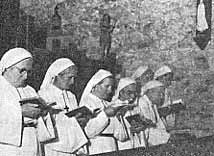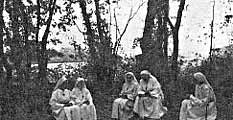

![]()
![]()
|
Religious
Communities for Women THE SISTERS OF LE RAFFLAY Active
Nuns “Their main purposes is to make the Gospel known and to spread the Word of God, as irresistible apostles striving to make people discover the “True Face” of the soft and humble-hearted Lord, the Lamb of God.” (Constitutions) At a time when Catholics wonder if it is timely for the laity to take over the apostolate, to make society and every single family more Christian, it is necessary to rediscover the traditional structures.
The Divine Office Today, Christianity has totally forgotten “the intermediary link” consisting in Active Nuns who used to run hospitals, nursing homes, reception homes of all kinds; thousands of sisters who used to go on foot or on their bicycles all over the country, along the roads or the paths, or climbed the stairs of the stairs of the slums to cure the sick, to catechize the members of the families and, no matter the way they were dressed, they were “the Sister” who entered every house to visit the poor and the rich, the healthy and the unhealthy, the faithful and the unfaithful. Without even speaking, they made people think of God, their way of life converted countries and Missions. The Tradition is finding its Carmels, monasteries, schools and boarding schools again, but it has not recovered its convents yet, the convents that innumerable Sisters used to leave, so humbly, going all over region preparing the way of the Lord, as John the Baptist did. Such was the Congregation of the Little Servants of the Lamb of God. Calvaries, churches and statues which have been destroyed are so many signs of the fading sacred; cassocks of frocks, cornets and white, black, gray of blue habits which are disappearing are so many reminders of God, whereas people form the Maghreb or members of various sects are proud of the badges they display. Active Nuns, Why? Is It Possible? Our society is sick. People look for God without being aware of it; is it not then the right moment for their good and that of the Church to start again all these active auxiliary congregations of the parishes, therefore of priories? In this now pagan world in which young people have never met active traditional Nuns, they would never think of a true religious life apart from Carmels, the monasteries or teaching and semi-contemplative orders having the Grand Office, partly or entirely. Then the well known temptation appears: instead of an active order, it is better to lead a consecrated life as a lay person who has much more freedom, even to help the Church. This is just taking no notice of the main thing: the ACTIVE NUN’S apostolate is first made through supernatural means: Mass, Divine Office, sacraments, daily duty offered to God, observance of vows and of a regular life in a deeper and deeper union with Our Lord Jesus Christ, because the nun has sacrificed everything for every single soul, as her cloistered or semi-contemplative sisters do, but in a different way, after a silent, community, doctrine and spiritual formation which lasts three years. In this spirit, at LE RAFFLAY, a small community is growing, willing to answer the present needs of the socio-medical field in the broad sense of the term.
The First Australian Perpetually Professed Sister (Feb. 2, 2000) Origin and History R. F. de la CHEVASNERIE, S.J. created the Institute of the Lamb of God. It happened in France (Brest), after the 2nd. World War. The Founder wanted an active congregation, open to all nationalities, without any nationalities, without any age limit, admitting fragile people, even disabled ones, in the same way as healthy people, on condition that their vocation should be real, that a community life should be possible, and that the aptitude of a humble docility of heart should be serious. 1968: In the middle of conciliar disruption, unable to stop the the disorder which was taking place, he died after writing his will and saying: “I cannot do any more for you but, from Heaven I will help you”. 1968: Mother Mary of Magdala, one of the five designated in his will to keep the spirit of the Insttitute, who has been the general bursar for 25 years, went to Africa (Cameroon) to start the first Mission. On coming back to France, 4 years later, she found a divided congregation, invaded by a modernistic and charismatic spirit…All experiences are permitted except that of Tradition. Then, with Mother Antoinette-Marie, she created the Little Servants of St. John the Baptist, who would remain faithful to the traditional Church and who recognized Father de la Chevasnerie as their posthumous founder. Very quickly, two more persons joined them. The small community, put under the patronage of St. John the Baptist, who once presented our Lord as the Lamb of God, found itself linked to its origins. When Providence intervenes Confiding in God, and putting themselves in the hands of His Blessed Will is what they have all chosen. Within two days, Providence showed Itself in a generous as well as unexpected way. It gave the exiles not only a roof but also an old house with a park and a wood (some 12.35 acres). The donor died two years later. He bequeathed an important sum of money to the growing community in order to enable the nuns to expand to have some works done. From 1980 to 1985, in prayer, silence, and discretion, their life is that of all foundations: clearing, alterations, constructions, St. Joseph being the financier: not a single debt, thanks to him. In the middle of this working site, everything organized itself. September 1984 saw the opening of the Novitiate. Spirituality “Following the Lamb”. The phrase “Lamb of God” crystallizes, epitomizes, symbolizes: The final spirit, the childlike spirit, the little way, the evangelical spirit. The LAMB has been the revealed and traditional symbol of the Lord for ages, maintained by the Church by being mostly expressive. Life in the mother-house: The day is divided into: ½ hour meditation, Tridentine Mass, Office, Spiritual reading, Rosary, ½ hour Adoration, Examination of conscience. 3-month Prepostulate, 6-month Postulate, 2-year Noviticiate, 6-year Temporary vows. 1991: The community consists of 12 professed, 3novices and 2 postulants, among whom are one Mexican and one Australian. It is open to everyone, as Father de la Chevanesrie wanted, without any age limit nor refusal of fragile people on condition that they should have an active vocation. The House has been turned into a rather functional convent in order to accommodate about 10 professed and some 30 novices. The day is punctuated by prayer and its spiritual exercises for about 3 hours and a half. As for the community life, it takes place during working-times, at mealtimes with reading, during recreations, lectures, classes, during the heavy work consisting mainly in the small farming concern with its pluri-rearing which makes it possible to live almost entirely on its production. Each nun take part in these works as far as she can. So, whereas some of them are working in the sacristy, the secretariat, the bursar’s office, the kitchen, the linen-room or the laundry… other go and plough, plant or take care of the various animals. The postulants and novices work for about 2 hours on their own each day: Sacred Scriptures, Catechism, History of the Church, study of the constitutions. Of course, like in all congregations, the inner and external silence is kept as much as possible in order to make life more united to God, the novitiate being the learning stage. Besides, everything is planned; no fantasy. The bell is rung for the end of the works; together with Obedience, are to remind that God is the sole Master on board.
Recreation Today at Le Rafflay It is already the beginning of a medico-social setting up:
But above all, these so different welcomes already represent a moral, professional and spiritual preparation for which each sister, as far as she can, has to help. To help means to be alert, interchangeable to be a feminine thoughtfulness which quickly understands what the host’s needs are, without ignoring the limits of the Community. The exercises of this poor, simple but warm welcome will make those who stop a few days peaceful and joyful again. It is, then, the learning of abnegation, self-negation, charity with others, and no matter whether there are qualifications or not, it is the application of the only diploma that is needed in our crazy world, the diploma of the happy walk to holiness which, alone, can make miracles and cure the souls and the bodies. Activities These will depend on each nun’s health. Of a medico-social vocation “The sisters will look after the sick, the elderly, the children, and everything which deals with those who suffer, with the spiritual good of the souls in view first”. (Constitutions) At home, in an establishment or on a mission.
Therefor they will exclude the big establishments that would make them dependent on the Civil Service, paralyzing their apostolate and making if difficult for each nun to be admitted. A wide recruitment is then necessary for all the different jobs to be fulfilled. It requires varied abilities, with or without diplomas (doctors, nurses, social workers, accountants, secretaries, cooks, linen maid, seamstresses, gardeners, farmers...) If we think of founding a few missions once we have developed, we plan, in the nearer future, to perform a medico-social action of a new kind, fitting modern needs, and not covered by the present legislation. A kind of haven of peace, a country house far from the noises of the city, a peaceful and quiet stopping place for people of all ages. An Establishment near the existing spiritual pole of the Community of LE RAFFLAY, but totally independent of it as for its organization. Rev. Mother
Superior Tel: [33] (40) 06 51 68
|


